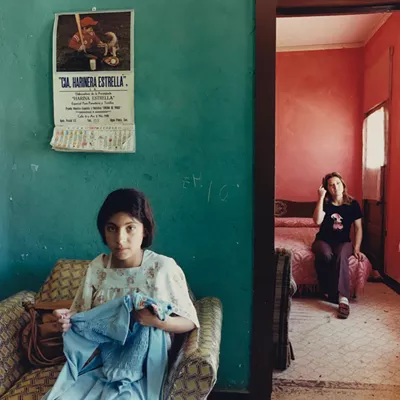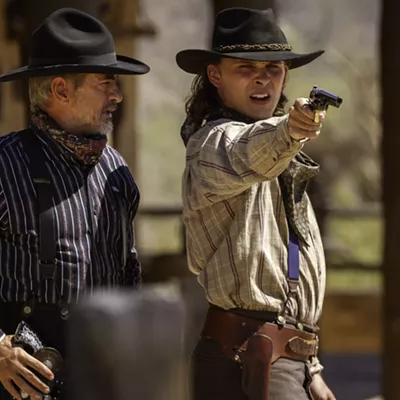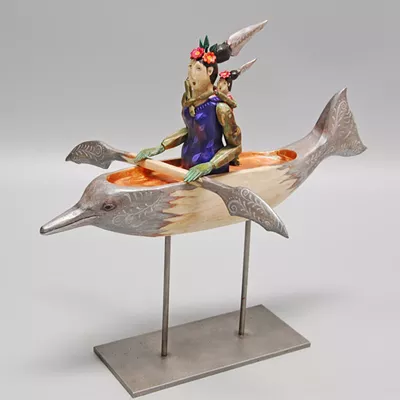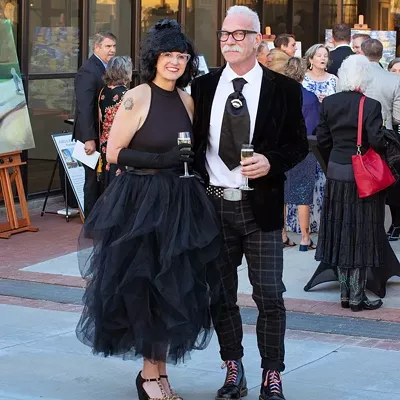
In the summer of 2020, the first year of COVID-19, photographer Wendi Schneider fled her home in Colorado to the green mountains of western North Carolina.
She had been there before and had found a peaceful place and mountains teeming with trees of oak, walnut, cherry and maple. In that early visit in 2016, she had made one of her most loved her photos, “Locust,” taken near Black Mountain. The tree is tall and, in the image, spindly, standing alone across a backdrop of mountains reaching up to the sky.
When she returned during the time of the pandemic in 2020, she rose early in the morning to a sky filled with mist. She had always pined for green after moving to Denver. As each morning moved on, she watched the colors change with the light. She began a new series, “Into the Mist.”
In “Into the Mist II,” rich green leaves surround the edge like a wreath, and, in its center, pale mist erases the distant mountains. In other photographs, it’s just the opposite. Tree branches fill the space, blocking the sun to shelter the forest floor and all the creatures below.
Schneider typically places her works in antique vintage frames. In that time of death and dying, the fancy frames were abandoned. Instead, she placed her pictures into frames that are plain, dark and black. But the trees still give us joy.
Schneider grew up among several generations of artists and studied art history and painting at Tulane University. She has said, “In 1981, I bought a Nikon to create references of models for my oil paintings.”
Later, she embraced photography, including the techniques of the dark room. While working as a photojournalist, she “fell in love with life through the lens.” But she did miss the oil paints. She began to experiment with translucent papers, vellum, Japanese kozo paper, and gold-leaf gilding. The result is work that is beautiful, unique, and almost painterly.
For the series “Into the Mist,” for example, she used hand-gilding that brought a golden shimmer to the pictures.
Tucsonans will be delighted to see the Arizona desert in two of her pictures in ‘States of Grace.” “Another World” and “Desert Mist” are stunning desert landscapes. Schneider employs the same techniques and motifs as in her North Carolina suite: golden morning light, silhouetted trees and misty mountains. But there’s nothing like the desert with its saguaro, mesquites, and prickly pear cacti.
Laurie Lambrecht’s art is also rooted in nature and her sense of place. In her case, it’s Bridgehampton on the Long Island Sound, a small farming community that has become a tourist town. She grew up there as a child, lived in New York City for many years, and eventually returned.
“In my neighborhood were poets, book editors, painters or illustrators, playwrights. For me, having a life in the arts was a normal thing.”
She lives surrounded by tidal basins, freshwater marshes, and mature oak woodlands. Like Schneider, she has a passion for trees. In her exhibition at Etherton, “Bark/Cloth,” we have 18 close-up photographs of bark, but in a surprising twist, they are printed on precious linen fabric and ornamented with her own hand-woven embroidery. Lambrecht learned to embroider in the Girl Scouts and as a teenager, she learned to sew working in a fancy dress shop for summer visitors. Later, as an adult, she designed sweaters. Today, she calls herself a textile artist.
In her piece, “Madoo,” named after a garden and conservancy on Long Island, Lambrecht photographed a slice of tree bark in its natural browns and grays. Then she endowed it with an unruly web of embroidery, stitched in delightful red, blue and teal.
There are 18 of her works in the Etherton show, taken in different places, in the west as well as the east. Each one is different — different textures of bark, different colors of thread, different pallets altogether. “Wyoming” has brilliant yellows, some from nature’s lichen, some from Lambrecht’s embroidery, against a chalky white background. “Santa Fe” has streams of blue and blood red threads on what looks like the white bark of an aspen. “Tucson,” of course, is in the mix. Its bark looks like stone; its stitching is silver and gold — an image that evokes both nature’s rocky canyons and the destructive mines made by humans.
Schneider and Lambrecht are making work that celebrates nature, but that doesn’t mean they are not giving a warning. The kind of beauty that fascinates them can be taken away.
Lambrecht’s photographs on linen have an unusual, unexpected quality that draws you in. She invites us to look closely at the world and think deeply. Schneider’s gold-tinted images have a timeless quality, yet in them nature sometimes seems fragile. The colors are dark, even perhaps ominous, as if a storm were coming. Together, their art calls us to protect these places, for if we don’t, we risk losing them.
Reverence: Laurie Lambrecht, “Black Cloth” Wendi Schneider, “Into the Mist” and “States of Grace”
WHEN: 11 a.m. to 5 p.m. Tuesday to Saturday
WHERE: Etherton Gallery, 340 S. Convent Avenue, Tucson
COST: Free
INFO: 520-624-7370, ethertongallery.com










